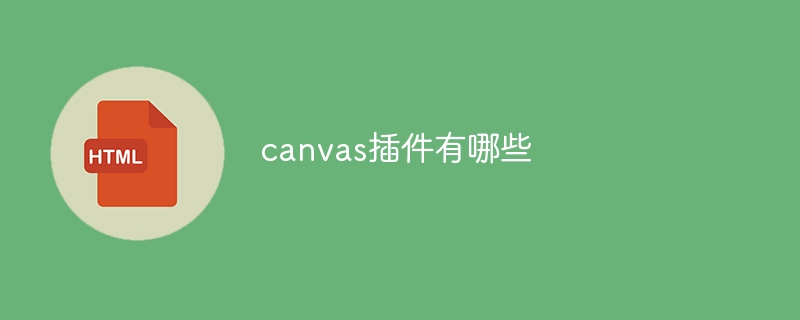We have had many articles about canvas before. If you are interested, you can take a look. One of them is about canvas drawing video. In fact, canvas has many functions. Let’s take a look today. Introducing the application of the ImageDate object of camvas.
ImageData object of canvas
The ImageData object stores the real pixel data of the canvas object. It contains the following read-only attributes:
width
Picture width, unit is pixels
Picture height, unit is pixels
data
Uint8ClampedArray type One-dimensional array contains integer data in RGBA format, ranging from 0 to 255 (inclusive of 255).
Create an ImageData object
To create a new, blank ImageData object, you should use the createImageData() method.
var myImageData = ctx.createImageData(width, height);
The above code creates a new ImageData object of a specific size. All pixels are preset to transparent black.
Get scene pixel data
In order to obtain an ImageData object containing canvas scene pixel data, you can use the getImageData() method:
var myImageData = ctx.getImageData(left, top, width, height);
This method will return an ImageData Object, which represents the object data of the canvas area. The four corners of the canvas are represented as (left, top), (left + width, top), (left, top + height), and (left + width, top + height) four points. These coordinate points are set as canvas coordinate space elements.
Write pixel data into the scene
You can use the putImageData() method to write pixel data into the scene.
ctx.putImageData(myImageData, dx, dy);
The dx and dy parameters represent the device coordinates obtained from the pixel data you want to draw in the upper left corner of the scene.
For example, in order to draw the image represented by myImageData in the upper left corner of the scene, you can write the following code:
ctx.putImageData(myImageData, 0, 0); toDataURL 将canvas转为 data URI格式
There is the following
<canvas id="canvas" width="5" height="5"></canvas>
var canvas = document.getElementById("canvas");
var dataURL = canvas.toDataURL();
console.log(dataURL);
// "data:image/png;base64,iVBORw0KGgoAAAANSUhEUgAAAAUAAAAFCAYAAACNby
// blAAAADElEQVQImWNgoBMAAABpAAFEI8ARAAAAAElFTkSuQmCC"
var fullQuality = canvas.toDataURL("image/jpeg", 1.0);
// data:image/jpeg;base64,/9j/4AAQSkZJRgABAQ...9oADAMBAAIRAxEAPwD/AD/6AP/Z"
var mediumQuality = canvas.toDataURL("image/jpeg", 0.5);
var lowQuality = canvas.toDataURL("image/jpeg", 0.1);
应用一:颜色选择器
var img = new Image();
img.src = 'haorooms.jpg';
var canvas = document.getElementById('canvas');
var ctx = canvas.getContext('2d');
img.onload = function() {
ctx.drawImage(img, 0, 0);
img.style.display = 'none';
};
var color = document.getElementById('color');
function pick(event) {
var x = event.layerX;
var y = event.layerY;
var pixel = ctx.getImageData(x, y, 1, 1);
var data = pixel.data;
console.log(data);
var rgba = 'rgba(' + data[0] + ',' + data[1] +
',' + data[2] + ',' + (data[3] / 255) + ')';
color.style.background = rgba;
color.textContent = rgba;
}
canvas.addEventListener('mousemove', pick);Application 2: Video solid color background filtering
Today, we use getImageData to filter out the solid color background.
let processor = {
timerCallback: function() {
if (this.video.paused || this.video.ended) {
return;
}
this.computeFrame();
let self = this;
setTimeout(function () {
self.timerCallback();
}, 0);
},
doLoad: function() {
this.video = document.getElementById("video");
this.c1 = document.getElementById("c1");
this.ctx1 = this.c1.getContext("2d");
this.c2 = document.getElementById("c2");
this.ctx2 = this.c2.getContext("2d");
let self = this;
this.video.addEventListener("play", function() {
self.width = self.video.videoWidth / 2;
self.height = self.video.videoHeight / 2;
self.timerCallback();
}, false);
},
computeFrame: function() {
this.ctx1.drawImage(this.video, 0, 0, this.width, this.height);
let frame = this.ctx1.getImageData(0, 0, this.width, this.height);
let l = frame.data.length / 4;
for (let i = 0; i < l; i++) {
let r = frame.data[i * 4 + 0];
let g = frame.data[i * 4 + 1];
let b = frame.data[i * 4 + 2];
if (g > 100 && r > 100 && b < 43)
frame.data[i * 4 + 3] = 0;
}
this.ctx2.putImageData(frame, 0, 0);
return;
}
};Application 3: Image grayscale and inverted color
In this example, we iterate through all pixels to change their values. Then we put the modified pixel array back into the canvas through putImageData(). The invert function just subtracts the maximum color value of the color by 255. The grayscale function just uses the average of red, green and blue. You can also use a weighted average, such as the formula x = 0.299r + 0.587g + 0.114b.
var img = new Image();
img.src = 'rhino.jpg';
img.onload = function() {
draw(this);
};
function draw(img) {
var canvas = document.getElementById('canvas');
var ctx = canvas.getContext('2d');
ctx.drawImage(img, 0, 0);
img.style.display = 'none';
var imageData = ctx.getImageData(0,0,canvas.width, canvas.height);
var data = imageData.data;
var invert = function() {
for (var i = 0; i < data.length; i += 4) {
data[i] = 225 - data[i]; // red
data[i + 1] = 225 - data[i + 1]; // green
data[i + 2] = 225 - data[i + 2]; // blue
}
ctx.putImageData(imageData, 0, 0);
};
var grayscale = function() {
for (var i = 0; i < data.length; i += 4) {
var avg = (data[i] + data[i +1] + data[i +2]) / 3;
data[i] = avg; // red
data[i + 1] = avg; // green
data[i + 2] = avg; // blue
}
ctx.putImageData(imageData, 0, 0);
};
var invertbtn = document.getElementById('invertbtn');
invertbtn.addEventListener('click', invert);
var grayscalebtn = document.getElementById('grayscalebtn');
grayscalebtn.addEventListener('click', grayscale);
}Application four-scaling and anti-aliasing
var img = new Image();
img.src = 'haorooms.jpg';
img.onload = function() {
draw(this);
};
function draw(img) {
var canvas = document.getElementById('canvas');
var ctx = canvas.getContext('2d');
ctx.drawImage(img, 0, 0);
img.style.display = 'none';
var zoomctx = document.getElementById('zoom').getContext('2d');
var smoothbtn = document.getElementById('smoothbtn');
var toggleSmoothing = function(event) {
zoomctx.imageSmoothingEnabled = this.checked;
zoomctx.mozImageSmoothingEnabled = this.checked;
zoomctx.webkitImageSmoothingEnabled = this.checked;
zoomctx.msImageSmoothingEnabled = this.checked;
};
smoothbtn.addEventListener('change', toggleSmoothing);
var zoom = function(event) {
var x = event.layerX;
var y = event.layerY;
zoomctx.drawImage(canvas,
Math.abs(x - 5),
Math.abs(y - 5),
10, 10,
0, 0,
200, 200);
};
canvas.addEventListener('mousemove', zoom);
}Application five-canvas hand-drawing and downloading pictures
window.addEventListener('load', function(ev) {
var sourceimage = document.querySelector('img');
var canvas = document.querySelector('canvas');
var link = document.querySelector('a');
var context = canvas.getContext('2d');
var mouseX = 0, mouseY = 0,
width = 300, height = 300,
mousedown = false;
canvas.width = width;
canvas.height = height;
context.fillStyle = 'hotpink';
function draw(ev) {
if (mousedown) {
var x = ev.layerX;
var y = ev.layerY;
x = (Math.ceil(x / 10) * 10) - 10;
y = (Math.ceil(y / 5) * 5) - 5;
context.fillRect(x, y, 10, 5);
}
}
var link = document.createElement('a');
link.innerHTML = '下载图片';
link.href = "#";
link.download = "haorooms.png";
document.body.insertBefore(link, canvas);
canvas.addEventListener('mouseover', function(ev) {
document.body.classList.add('painted');
}, false);
canvas.addEventListener('mousemove', draw, false);
canvas.addEventListener('mousedown', function(ev) {
mousedown = true;
}, false );
canvas.addEventListener('mouseup', function(ev) {
link.href = canvas.toDataURL();
mousedown = false;
}, false );
} ,false);I believe after reading these cases You have mastered the method. For more exciting information, please pay attention to other related articles on the php Chinese website!
Related reading:
How to make the loading effect of CSS3
How to make it with css3 Icon effect
The above is the detailed content of How to use ImageData of canvas. For more information, please follow other related articles on the PHP Chinese website!
 Vue和Canvas:如何实现手写签名和手势识别功能Jul 18, 2023 am 08:49 AM
Vue和Canvas:如何实现手写签名和手势识别功能Jul 18, 2023 am 08:49 AMVue和Canvas:如何实现手写签名和手势识别功能引言:手写签名和手势识别功能在现代应用程序中越来越常见,它们可以为用户提供更加直观和自然的交互方式。Vue.js作为一款流行的前端框架,搭配Canvas元素可以实现这两个功能。本文将介绍如何使用Vue.js和Canvas元素来实现手写签名和手势识别功能,并给出相应的代码示例。一、手写签名功能实现要实现手写签
 Canvas的优势有哪些Aug 17, 2023 pm 04:52 PM
Canvas的优势有哪些Aug 17, 2023 pm 04:52 PMcanvas的优势有强大的绘图功能、高性能、跨平台兼容性、支持多种图形格式、可以与其他Web技术集成、可以实现动态效果和可以实现复杂的图像处理。详细介绍:1、Canvas提供了丰富的绘图功能,可以绘制各种形状、线条、文本、图像等;2、Canvas在浏览器中直接操作像素,因此具有很高的性能;3、Canvas是基于HTML5标准的一部分,可以在各种现代浏览器上运行等等。
 canvas特效有哪些Aug 18, 2023 pm 04:12 PM
canvas特效有哪些Aug 18, 2023 pm 04:12 PMcanvas特效有粒子效果、线条动画、图片处理、文字动画、音频可视化、3D效果、游戏开发等。详细介绍:1、粒子效果,通过控制粒子的位置、速度和颜色等属性来实现各种效果,如烟花、雨滴、星空等;2、线条动画,通过在画布上绘制连续的线条,创建出各种动态的线条效果;3、图片处理,通过对图片进行处理,可以实现各种炫酷的效果,如图片切换、图片特效等;4、文字动画等等特性。
 如何利用Vue和Canvas创建逼真的天气动态背景Jul 17, 2023 am 08:33 AM
如何利用Vue和Canvas创建逼真的天气动态背景Jul 17, 2023 am 08:33 AM如何利用Vue和Canvas创建逼真的天气动态背景引言:在现代网页设计中,动态背景效果是吸引用户眼球的重要元素之一。本文将介绍如何利用Vue和Canvas技术来创建一个逼真的天气动态背景效果。通过代码示例,你将学习如何编写Vue组件和利用Canvas绘制不同天气场景,从而实现一个独特而吸引人的背景效果。步骤一:创建Vue项目首先,我们需要创建一个Vue项目。
 canvas插件有哪些Aug 17, 2023 pm 05:00 PM
canvas插件有哪些Aug 17, 2023 pm 05:00 PMcanvas插件有Fabric.js、EaselJS、Konva.js、Three.js、Paper.js、Chart.js和Phaser。详细介绍:1、Fabric.js 是一个基于Canvas的开源 JavaScript 库,它提供了一些强大的功能;2、EaselJS是CreateJS库中的一个模块,它提供了一套简化了Canvas编程的API;3、Konva.js等等。
 Vue和Canvas:如何实现图片的马赛克效果Jul 16, 2023 pm 10:17 PM
Vue和Canvas:如何实现图片的马赛克效果Jul 16, 2023 pm 10:17 PMVue和Canvas:如何实现图片的马赛克效果引言:随着Web技术的不断发展,越来越多的人开始使用Vue框架来构建交互式的前端应用。而在前端开发中,常常需要为用户提供图片处理的功能。本文将介绍如何利用Vue和Canvas实现图片的马赛克效果,为用户带来更好的视觉体验。一、马赛克效果概述马赛克效果是一种将图像的细节部分进行像素化处理,使得整个图像变得模糊和抽象
 canvas引擎有哪些Aug 17, 2023 pm 05:29 PM
canvas引擎有哪些Aug 17, 2023 pm 05:29 PMcanvas引擎有Three.js、Pixi.js、EaselJS、Konva.js、Paper.js等。详细介绍:1、Pixi.js,提供了简单易用的API,支持精灵、纹理、滤镜等功能,同时还提供了丰富的工具和插件,方便开发者进行交互、动画和优化等操作;2、Pixi.js,提供了简单易用的API,支持精灵、纹理、滤镜等功能,还提供了丰富的工具和插件;3、EaselJS等等。
 如何使用Vue和Canvas开发网页截图工具Jul 19, 2023 am 08:36 AM
如何使用Vue和Canvas开发网页截图工具Jul 19, 2023 am 08:36 AM如何使用Vue和Canvas开发网页截图工具简介:随着互联网的发展,网页截图工具在我们的日常生活中扮演着越来越重要的角色。它们可以用来捕捉网页上的信息、制作教程或者分享你的见解。本文将介绍如何使用Vue和Canvas来开发一个简单的网页截图工具,以帮助读者了解如何实现这个常见但又有趣的功能。准备工作:在开始之前,我们需要准备好以下的开发环境和工具:安装Nod


Hot AI Tools

Undresser.AI Undress
AI-powered app for creating realistic nude photos

AI Clothes Remover
Online AI tool for removing clothes from photos.

Undress AI Tool
Undress images for free

Clothoff.io
AI clothes remover

AI Hentai Generator
Generate AI Hentai for free.

Hot Article

Hot Tools

MantisBT
Mantis is an easy-to-deploy web-based defect tracking tool designed to aid in product defect tracking. It requires PHP, MySQL and a web server. Check out our demo and hosting services.

mPDF
mPDF is a PHP library that can generate PDF files from UTF-8 encoded HTML. The original author, Ian Back, wrote mPDF to output PDF files "on the fly" from his website and handle different languages. It is slower than original scripts like HTML2FPDF and produces larger files when using Unicode fonts, but supports CSS styles etc. and has a lot of enhancements. Supports almost all languages, including RTL (Arabic and Hebrew) and CJK (Chinese, Japanese and Korean). Supports nested block-level elements (such as P, DIV),

Zend Studio 13.0.1
Powerful PHP integrated development environment

Dreamweaver CS6
Visual web development tools

Safe Exam Browser
Safe Exam Browser is a secure browser environment for taking online exams securely. This software turns any computer into a secure workstation. It controls access to any utility and prevents students from using unauthorized resources.






